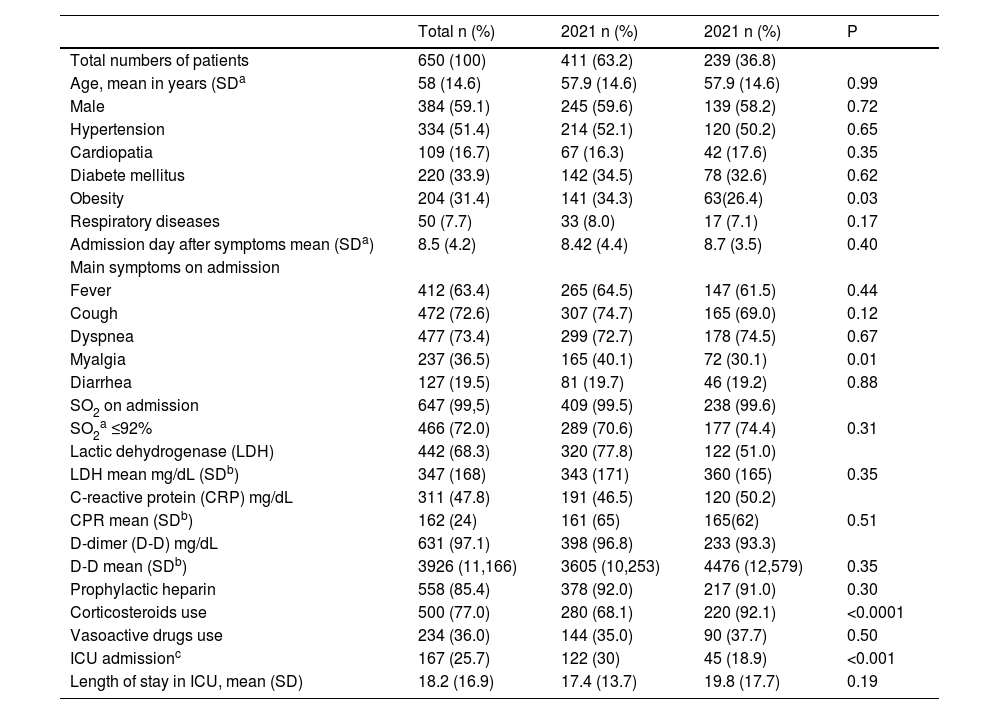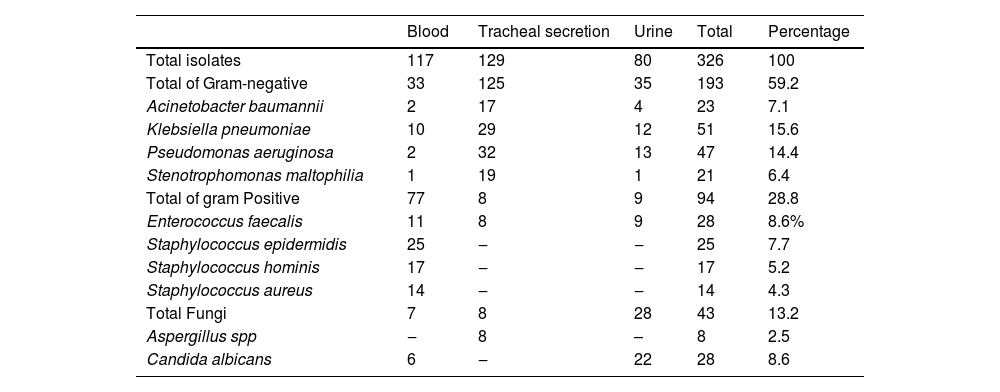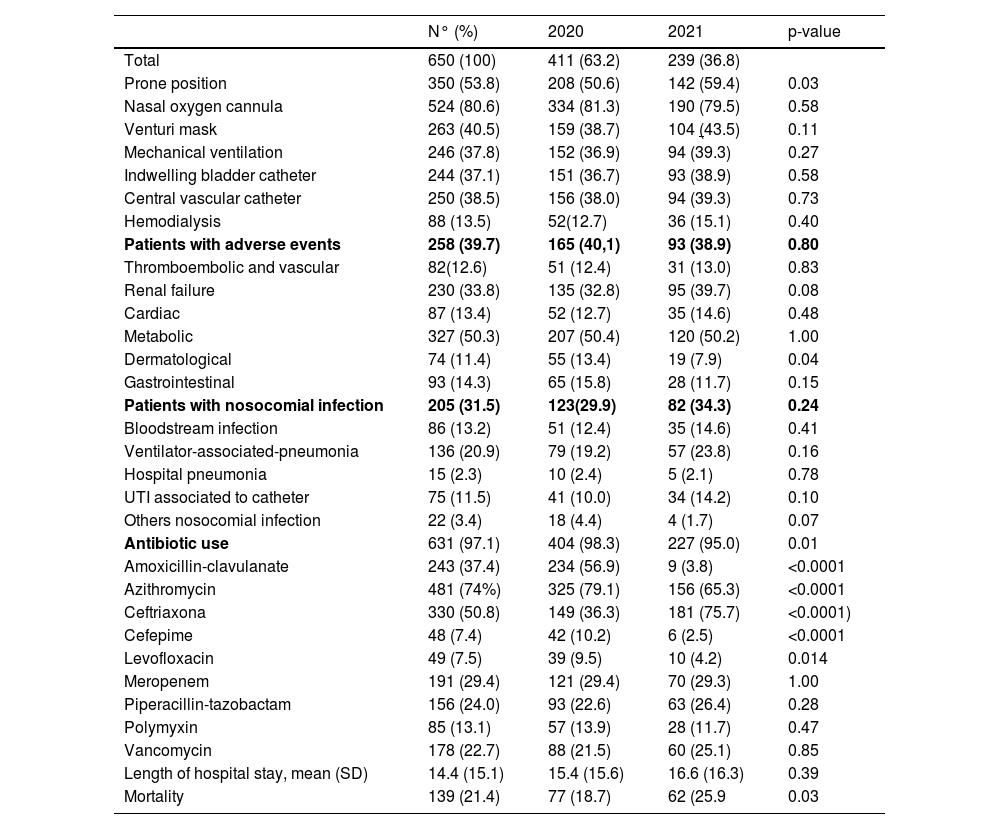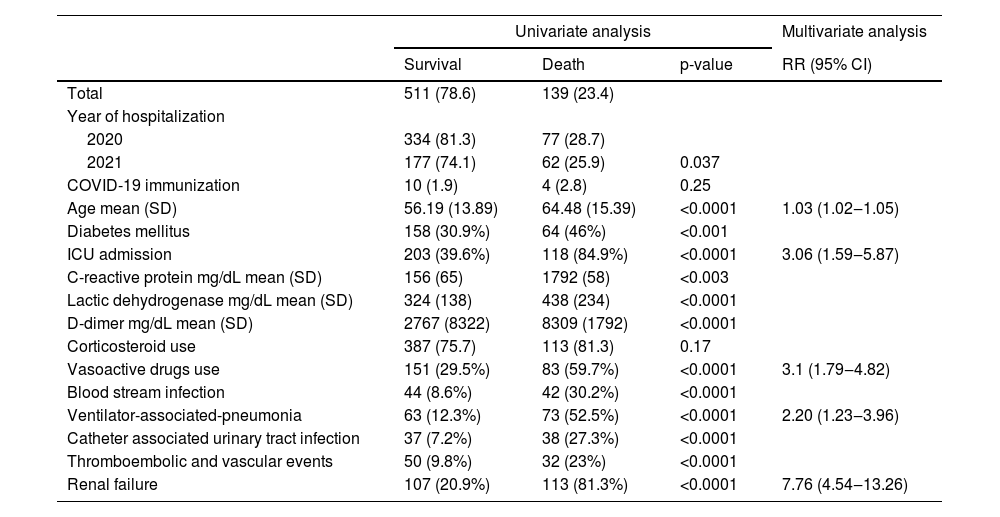Patients hospitalized with COVID-19 are often submitted to invasive procedures and they are at risk for hospital-associated adverse events.
ObjectivesTo evaluate the epidemiological and clinical aspects of patients hospitalized with COVID-19; the occurrence of adverse events and the risk factors for mortality.
MethodCohort study that included adult patients hospitalized with a diagnosis of SARSCoV-2 infection, at the tertiary University Hospital of UNICAMP from March 2020 to March 2021. Patients were identified through the hospital epidemiological surveillance system and followed until discharge or death. Descriptive, comparative, and logistic regression analysis was performed.
Results650 adult patients were included. The main adverse events identified were nosocomial infections (31.5%), renal failure (33.8%), thromboembolic and vascular events (12.6%). Mortality was higher among those with bloodstream infections (30.2% vs. 8.6%; p < 0.0001), ventilator-associated pneumonia (VAP, 52.5% vs. 12.3%; p < 0.0001), catheter associated urinary infection (27.3% vs. 7.2%; p < 0.0001); thromboembolic and vascular events (23.0% vs. 9.9%; p < 0.0001) and renal failure (81.3% vs. 20.9%; p < 0.0001). Klebsiella pneumoniae (15.6%), Pseudomonas aeruginosa (14.4%), Enterococcus faecalis (8.6%) were the most isolated bacteria. Logistic regression analysis identified age, (RR = 1.03; 95% CI 1.02 to 1.05); ICU admission (RR = 3.06; 95% CI 1.59 to 5.87), vasoactive drug use (RR = 3.1; 95% CI 1.79 to 4.82); renal failure (RR = 7.76; 95% CI 4.54 to 13.26); and VAP (RR = 2.2; 95% CI 1.23 to 3.96), independently associated with mortality.
Conclusionadverse events have an important impact on the evolution of patients with COVID-19, reinforcing the need for optimized prevention and control measures as an essential part of care for these patients.
The COVID-19 pandemic was characterized by great magnitude, morbidity, and mortality.1,2 The unfavorable evolution has been associated with immunopathological events, cardiac, renal, neurological, and infectious complications. Hospitalized patients, mainly in Intensive Care Units (ICU), are at higher risk of adverse hospital events.3,4
A Brazilian study carried out in a large hospital observed association between NI in patients admitted to the ICU due to COVID-19 and mortality.3
According to the World Health Organization (WHO), about 15% of COVID-19 cases develop a bacterial infection.5 In patients admitted to the ward, mortality has been observed at 15% to 20%, and in ICU patients 40%.6-8 Mortality can be twice as high in patients with nosocomial infection when compared to those without infection (15.4% vs. 7.3%).4
The objectives of this study were to assess the frequency of adverse events among patients hospitalized with COVID-19 and the risk factors associated with mortality during the hospitalization. We hypothesized that adverse events, particularly nosocomial infections have a negative impact on the outcome of these patients.
Material and methodsWe carry out a cohort study including all consecutive patients who were admitted to tertiary Hospital of State University of Campinas (HC-UNICAMP), from March 2020 to March 2021. The criteria for inclusion were aged > 18 years, severe and confirmed diagnosis of COVID-19. Patients were identified by the hospital epidemiological surveillance system and followed throughout until discharge or death. We collect demographic variables, medical history, clinical and laboratory data from each patient. The occurrence of adverse events and the evolution to death were the outcomes of interest.
Severe COVID-19 was defined by dyspnea, respiratory rate of 30 or more breaths per minute, a blood oxygen saturation of 93% or less.1,9
The patients did not receive antivirals or immunobiological to treat COVID-19 during the period study. Information on vaccination history (against COVID-19) was only collected from February 2019, since the COVID-19 vaccine was not available to the general population until that moment.
Adverse events and nosocomial infection were defined according to Anvisa (Agência Nacional de Vigilância Sanitária) criteria.10,11
We used a standardized instrument for data collection, which was stored in RedCap (https://redcap.fcm.unicamp.br/).
Categorical variables were described as frequency and percentage and continuous variables as mean and standard deviation. In comparative analyses, the Chi-Square and Student's t-test were used for categorical and continuous variables, respectively. Two-tailed p-values < 0.05 were accepted as statistically significant.
In January 2021 there was an increase in the number of reported cases due to the circulation of a new variant of SARS-CoV-2, in Brazil. For this reason, in addition to presenting the data of all patients together, the data were also presented separately (hospitalizations in 2020 and 2021), in order to assess whether there were differences between the mentioned periods. Variables associated with the evolution to death were included in the logistic regression analysis using the backward conditional technique. The IBM SPSS Statistics, version 21.0, for Windows was used for the statistical analysis.
The research was approved by the medical ethics committee (CAAE: 31783420.7.0000.5404).
ResultsDuring the study period, 1068 patients admitted to the hospital had a positive RT-PCR test (Real-Time-Polymerase Chain Reaction) for COVID-19; 650 patients had severe acute respiratory syndrome on hospital admission and were included in the study; 418 were cases identified in screening surveillance of patients hospitalized for other reasons or contacts of confirmed cases and were excluded. The characteristics of the patients by year of hospitalization are described in Table 1. Only 14 (2.1%) patients admitted in February and March 2021 had received a vaccine against COVID-19 before the hospitalization (Table 2).
Patient characteristics, clinical symptoms, laboratory data by year of admission.
| Total n (%) | 2021 n (%) | 2021 n (%) | P | |
|---|---|---|---|---|
| Total numbers of patients | 650 (100) | 411 (63.2) | 239 (36.8) | |
| Age, mean in years (SDa | 58 (14.6) | 57.9 (14.6) | 57.9 (14.6) | 0.99 |
| Male | 384 (59.1) | 245 (59.6) | 139 (58.2) | 0.72 |
| Hypertension | 334 (51.4) | 214 (52.1) | 120 (50.2) | 0.65 |
| Cardiopatia | 109 (16.7) | 67 (16.3) | 42 (17.6) | 0.35 |
| Diabete mellitus | 220 (33.9) | 142 (34.5) | 78 (32.6) | 0.62 |
| Obesity | 204 (31.4) | 141 (34.3) | 63(26.4) | 0.03 |
| Respiratory diseases | 50 (7.7) | 33 (8.0) | 17 (7.1) | 0.17 |
| Admission day after symptoms mean (SDa) | 8.5 (4.2) | 8.42 (4.4) | 8.7 (3.5) | 0.40 |
| Main symptoms on admission | ||||
| Fever | 412 (63.4) | 265 (64.5) | 147 (61.5) | 0.44 |
| Cough | 472 (72.6) | 307 (74.7) | 165 (69.0) | 0.12 |
| Dyspnea | 477 (73.4) | 299 (72.7) | 178 (74.5) | 0.67 |
| Myalgia | 237 (36.5) | 165 (40.1) | 72 (30.1) | 0.01 |
| Diarrhea | 127 (19.5) | 81 (19.7) | 46 (19.2) | 0.88 |
| SO2 on admission | 647 (99,5) | 409 (99.5) | 238 (99.6) | |
| SO2a ≤92% | 466 (72.0) | 289 (70.6) | 177 (74.4) | 0.31 |
| Lactic dehydrogenase (LDH) | 442 (68.3) | 320 (77.8) | 122 (51.0) | |
| LDH mean mg/dL (SDb) | 347 (168) | 343 (171) | 360 (165) | 0.35 |
| C-reactive protein (CRP) mg/dL | 311 (47.8) | 191 (46.5) | 120 (50.2) | |
| CPR mean (SDb) | 162 (24) | 161 (65) | 165(62) | 0.51 |
| D-dimer (D-D) mg/dL | 631 (97.1) | 398 (96.8) | 233 (93.3) | |
| D-D mean (SDb) | 3926 (11,166) | 3605 (10,253) | 4476 (12,579) | 0.35 |
| Prophylactic heparin | 558 (85.4) | 378 (92.0) | 217 (91.0) | 0.30 |
| Corticosteroids use | 500 (77.0) | 280 (68.1) | 220 (92.1) | <0.0001 |
| Vasoactive drugs use | 234 (36.0) | 144 (35.0) | 90 (37.7) | 0.50 |
| ICU admissionc | 167 (25.7) | 122 (30) | 45 (18.9) | <0.001 |
| Length of stay in ICU, mean (SD) | 18.2 (16.9) | 17.4 (13.7) | 19.8 (17.7) | 0.19 |
Isolated bacteria in culture from patients with COVID-19.
One patient could have more than one isolated microorganism.
Considering all patients included the mean age was 58 (Standard Deviation [SD = 14.6]) years, with 59.1% (384) men. Most patients had underlying diseases (87.9%), described in Table 1. The mean in days from the onset of symptoms to admission was 8.5 (SD = 4.2). The main symptoms presented until admission were fever (63.4%), cough (72.6%); dyspnea (73.4%); 72.0% of patients had oxygen saturation ≤ 92% on admission. Prophylactic heparin was administered to 558 (85.4%) patients and corticosteroids to 500 (77.0%) (Table 1).
Although the majority of hospitalized patients for COVID-19 during the study period underwent chest CT (n = 530, 79.7%), due to the large number of hospitalizations and overload of the care service, only 193 (29.7%) were interpreted and reported by a radiologist. We present data only from these reported exams. Bilateral involvement was reported in 180 (93.3%), with evidence of a ground-glass pattern in 185 (95.9%); in addition, 44.4% (86) of the patients had between 25% and 50% pulmonary involvement. The ventilatory assistance used by patients is described in Table 3. Non-invasive ventilation was used in 33 (5.0%) patients and high flow cannula in 52 patients (8.0%).
Procedures, adverse events, antibiotic use and mortality, by year of admission.
One patient could have more than one adverse event; One patient could have used more than antibiotic.
During the hospital stay, several invasive procedures were performed, and the most frequent were indwelling bladder catheterization in 244 (37.1%) patients, and central venous catheter in 250 (38.5%). Hemodialysis was required in 88 (13.5%) of the cases. The antibiotics used by patients are described in Table 3.
Adverse events occurred in 258 (39.7%) patients during hospitalization. The main adverse events were kidney failure 230 (33.8%), nosocomial infection (31.5%), and thromboembolic e vascular events in 82 (12.6%) patients (Table 3).
When assessing patients who had thromboembolic events, we observed a statistically significant association with male gender (15.9% vs. 7.9%; p = 0.003), mean initial d-Dimer values (10,418.0 ng/mL vs. 3011.3 ng/mL; p = 0.003); acute renal failure (19.1% vs. 9.3%; p = 0.001) and the occurrence of NI (24.4% vs. 7.3%; p < 0.0001). Of the 82 patients who had thromboembolic events, 63 (76.8%) occurred in individuals admitted to the ICU.
A total of 334 NI was diagnosed in 205 patients (31.5%) during hospitalization. The main infections were 136 ventilator-associated pneumonia (VAP, 20.9%), 86 bloodstream infection (BSI, 13.2%) and 75 catheter-associated urinary tract infection (CAUTI, 11.5%) (Table 3).
The main agents isolated were gram-negative bacteria, which corresponded to 193 (59.2%) of the isolates, followed by gram-positive bacteria in 94 (28.8%) and fungi in 43 (13.2%) isolates (Table 2). The main gram-negative bacteria identified were: Klebsiella pneumoniae (16.4%), with 49% (25) resistant to third-generation cephalosporins, 49% (25) resistant to ciprofloxacin and 39.2% (20) resistant to carbapenems; Pseudomonas aeruginosa (14.4%), with 10.6% (5) resistant to third-generation cephalosporins and 27.7% (13) resistant to carbapenems; Acinetobacter baumannii (7.1%), being 56.5% (13) resistant to amikacin, 56.5% (13) to ciprofloxacin, 56.5% (13) to third generation cephalosporins and 56.5% (13) to carbapenems.
Among the gram-positive bacteria, Enterococcus faecalis was identified in 8.6% of the isolates, with 32.1% (9) resistant to ampicillin; Staphylococcus epidermidis (7.7%), with 56% (14) resistant to oxacillin; Staphylococcus hominis (5.2%), with 17.7% (3) resistant to oxacillin; and Staphylococcus aureus (4.3%), with 57.1% (8) resistant to oxacillin.
Meropenem (29.4%), piperacillin-tazobactam (24%), and cefepime (7.38%) were the main antimicrobials prescribed for the treatment of NI (Table 2).
The length of hospital stay was 14.4 (SD = 15.1) days; and 139 (21.4%) patients died (Table 3).
The patients admitted in 2020 and 2021 were different in the frequency of obesity, ICU admission rate, use of the prone position, corticosteroid and antibiotic use at admission and mortality in the univariate analysis, but not in multivariate analysis.
Comparing the patients who died with those who survived, we observed a statistically significant difference in the variables: year of admission, age, presence of diabetes mellitus, ICU admission, d-dimer mean, C-reactive protein mean, lactic dehydrogenase mean, use of vasoactive drugs, occurrence of thromboembolic and vascular events, renal failure and occurrence of nosocomial infections (Table 4). In the logistic regression analysis, independent variables associated with death were age, ICU admission, use of vasoactive drugs, renal failure, and the occurrence of VAP (Table 4).
Risk factors associated to mortality in the univariate and in the multivariate analysis.
RR, Relative Risk; 95% CI, 95% Confidence Interval; SD, Standard Deviation; mg/dL, milligrams per deciliter.
The data from our study agree with international publications in many aspects, such as the predominance of males and the elderly population. In Brazil, according to the Ministry of Health, until Epidemiological Week 51, among patients with severe acute respiratory syndrome due to COVID-19, 50.8% were male and the age group of 70‒79 years old corresponded to 15.7% of cases.12
People with comorbidities are at greater risk of hospitalization and severe COVID-19. Cardiovascular and endocrinological diseases were the most frequently identified in this study.
Laboratory alterations in patients with COVID-19 reflect the direct damage caused by the virus to different systems or result from the immune response and procoagulant state. The most frequent laboratory findings described by other authors are neutrophilia and lymphopenia, increased lactate and lactate dehydrogenase, increased C-reactive protein, and ferritin.1,14 These laboratory alterations were also observed in the present study.
The procoagulant state observed in patients with COVID-19 is identified as a causal factor for a high frequency of thromboembolic events such as venous thrombosis, pulmonary embolism, and stroke. This can be explained by excessive inflammation, expressed by high levels of d-dimer and fibrinogen in the blood, which together with hypoxia increases the chance of thromboembolic adverse events. Due to this risk, prophylactic use of anticoagulants has been recommended to patients hospitalized for COVID-19.1,9 Prophylactic heparin was administered in 85% of the patients included in this study, following the protocol recommendations of our institution and the international literature throughout the analyzed period.9,13
In China, Italy, United States, and France, thrombolytic adverse events were reported in more than 30% of patients admitted to the Intensive Care Unit (ICU). In France, these events occurred in 22% of cases despite the prophylactic use of anticoagulants.14
In the present study, thromboembolic events occurred in 82 (12.6%) patients, less than described in the literature. Eventually, we can hypothesize that there was underdiagnosis since there were difficulties in performing angiotomography in all patients in whom the suspicion of thromboembolic phenomenon was raised. Another possible explanation of our findings may be the difference in calculating the occurrence of these phenomena, considering all hospitalized patients or just those in the ICU, who certainly have a higher risk of thromboembolism, either due to the severity of the disease itself or other associated risk factors. In our sample, 63 (76.8%) of the thromboembolic events occurred in patients admitted to the ICU.
Renal failure is frequently observed as a complication of COVID-19 and has been reported in 14% to 29% of patients.15 It is believed that renal injury may be due to direct injury by the SARS-CoV-2 virus, or secondary to the action of inflammatory cytokines associated with sepsis, thus causing dysfunction of multiple organs, including the kidney.14 In the patients in our study, 12.3% developed dialytic renal failure.
In the present study, among the adverse events observed, infections were very frequent. NI occurred in 31.5% of cases, the most frequent VAP (20.9%) and BSI (13.2%).
In a study carried out in eight Italian hospitals with 774 patients with COVID-19, 359 patients (46%) had 759 NI. VAP was diagnosed in 50% and BSI in 34%. Gram-negative bacteria (especially Enterobacteriaceae) and Staphylococcus aureus were isolated in 64% and 28% of VAP cases, respectively.16
Overall, we observed a higher frequency of gram-negative bacteria (62.1%), followed by gram-positive bacteria (27%) and fungi (13.8%).
In a study conducted with 73 patients diagnosed with COVID-19 at the Hospital das Clínicas da Faculdade de Medicina da Universidade Estadual de São Paulo (HC-FMUSP), it was observed that 38% of the cases had VAP, similar to our series, however with a predominance of Staphylococcus aureus. The most frequent gram-negative bacteria were: Klebsiella pneumoniae, Acinetobacter baumannii, and Pseudomonas aeruginosa, as observed in this study.17
In a tertiary hospital in Rio de Janeiro the positivity of blood cultures was observed in patients hospitalized in a critical situation before the pandemic and after COVID-19, where they were observed a significant increase of BSI caused by multi drug resistant gram-negative bacilli, as enterobacteria producer of extended-spectrum beta-lactamase (2.9 vs. 6.1 × 1000), carbapenemases producers (9.4 vs. 12.4/1000) and carbapenem-resistant Pseudomonas aeruginosa (1.4 vs. 3.9/1000).18 In the present work, we also observed gram-negative bacteria with high resistance rate to beta-lactams and carbapenems.
The use of antimicrobials should be used in the management of COVID-19 for the treatment of co-infection or NI, mainly bacterial or fungal respiratory infections. However, it has been observed that the proportion of patients using antimicrobials is much higher than the documentation of overlapping infections.19,20
One can understand the difficulties for clinician differentiate alterations resulting from viral damage and overlapping bacterial infection.
In the present study, the majority of the patients used antimicrobials at admission due to the possibility of bacterial co-infection, particularly in the first year of the pandemic, and in the last month of the study decreased.5,6
The mortality rate reported among patients with COVID has been variable (7.6% and 25.6%) and has changed according to the evolution of pandemic.7,8,21,22 In Mexico City, a study was carried out in a tertiary hospital between February 26, 2020, and June 5, 2020, including 800 patients hospitalized for COVID-19 with acute respiratory distress syndrome. The mortality rate was 30.1% and was associated with low oxygen saturation on admission (RR = 4.8, 95% CI 3.26–7.31).21
On the RECOVER-SUS, a study carried out in multiple Brazilian tertiary hospitals and including 1589 patients, 429 individuals (27% [95% CI 24.8–29.2]) died during hospitalization (mean time of 14 [IQR 9–24] days).22
The mortality rate in the present study was 21.4% and it was greater in patients admitted in 2021 compared to 2020 (25.9% vs. 18.7%). It is worth noting that from January to March there was an increase in notified cases of COVID-19 and deaths, in Campinas, attributed to a new variant circulation. However, in the multivariate analysis the year of hospitalization was not independently associated with mortality.23
Age, ICU stay, use of vasoactive drugs, development of acute kidney failure, and the occurrence of NI, particularly VAP, were the variables independently associated with the evolution to death in the present study.
Age is a frequently identified risk factor for mortality, due to the frequency of comorbidities and the immunosenescence observed in this population.
Dialytic and non-dialytic renal failure during hospitalization has been reported in 6.7% of patients with acute distress syndrome, with mortality of 91.7%.24
A study that compared the occurrence of NI in ICUs between a period without COVID-19 (2019) and a pandemic period (2020), including 7775 patients admitted to ICUs in low- and middle-income countries, reported an incidence of BSI of 2.5 in 2019 and 4.7 in 2020 (RR = 1.85, p = 0.0006), whereas in VAP the rates were 9.7 in 2019 and 12.6 in 2020 and urinary tract infections had rates of 1.6 in 2019 and 1.4 in 2020 (RR = 1.14; p = 0.69). The mortality rate in patients affected by infections in 2020 was 7.5 compared to the rate of 6 in 2019 (RR = 1.42; p < 0.0001).25
In our study, nosocomial infection was higher among patients who died. A review of eleven studies on mortality in patients with COVID-19 observed an increase in mortality of 42.7% (95% CI 34–51.7%) in the presence of VAP.26 This is a known association between VAP and high mortality rates, either due to diagnostic difficulties and/or the administration of correct empirical therapy.
The main limitation of the study was to include patients from a single center, on the other hand, we have the strength of having carried out a cohort study that included a large number of patients from a tertiary public hospital.
Our study corroborates that, due to the severity of the cases and the care needs in the ICU, patients with COVID-19 are more subject to NI and hospital-associated adverse events and these have an important impact on mortality.
ConclusionsThe analysis of patients with severe acute respiratory disease due to COVID-19 admitted at HC-UNICAMP from March 2020 to March 2021 showed a high percentage of patients with adverse events, particularly acute renal failure, thromboembolic and vascular events, and NI.
The use of antimicrobials was widespread, beyond what was expected given the frequency of documented infections.
The risk of death was higher in older patients admitted to the ICU, those who used vasoactive drugs, had adverse events such as renal failure and VAP. The bacteria most frequently isolated from NI in these patients were Acinetobacter baumannii, Klebsiella pneumoniae, Pseudomonas aeruginosa, Enterococcus faecalis, and Staphylococcus epidermidis.
COVID-19 infection is associated with high mortality in patients with comorbidities, who need ICU care, especially if other risk factors are added, such as the occurrence of adverse events, reinforcing the need to implement prevention and control measures, optimized as an essential part of care for these patients.
Authors' contributionsConception and design: Lucieni de Oliveira Conterno.
Analysis and interpretation of data: All.
Drafting of manuscript: Maitê Vasconcelos Luz, Lucieni de Oliveira Conterno, Julian Furtado Silva e Hugo Dugolin Ceccato.
Supervision: Lucieni de Oliveira Conterno
Financial supportThis project was funded by process n 20/10439-3, Fundação de Amparo à Pesquisa do Estado de São Paulo (FAPESP) on behalf of Maitê Vasconcelos Luz.
This project is part of the RECOVID group, led by Mônica Corso Pereira. Registered at the National Center for Scientific and Technological Development (CNPq
The local ethics committee (research ethics committee of University Hospital) approved the design of this study. CAAE: 31783420.7.0000.5404.
Consent for publicationAll authors approved the final version submitted.








